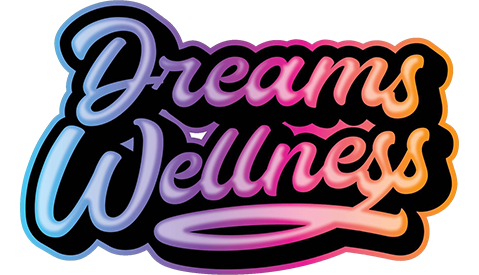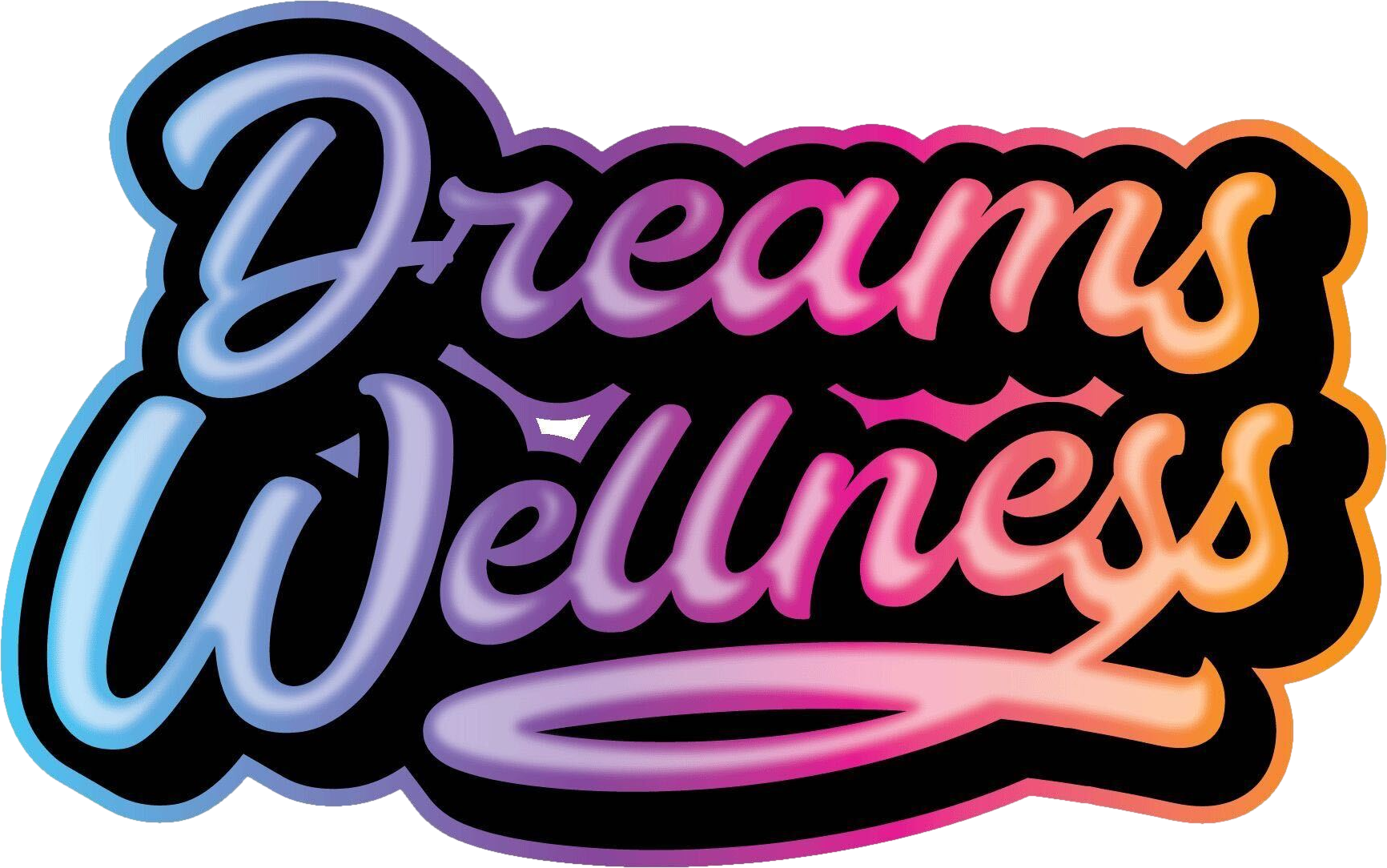Edible Timeline -The Complete Guide
The cannabis scene in Washington, DC, is up and thriving. Cannabis dispensaries are popping up around the city with delectable cannabis treats. Embark on a flavorful expedition through the world of cannabis-infused delights with this comprehensive guide. This carefully curated journey will invite you to dive into the evolution of cannabis edibles and trace their origins, innovations, and the milestones that have shaped the landscape of DC’s favorite weed treats. From ancient roots of cannabis-infused gifts to the contemporary explosion of gourmet cannabis edibles, this guide is crucial for understanding how infused treats have transitioned from traditional practices to becoming the diverse and sophisticated offerings available today. Let’s dive into what edibles are, how long edibles last in your system, types of edibles, and where to purchase the best cannabis edibles on the market!
What Are Edibles and How Are They Made?
So, let’s start by understanding what edibles are and how they are made. Edibles are food products or beverages infused with tetrahydrocannabinol (THC) and other cannabinoids, sometimes** cannabidiol** (CBD), which are compounds found in the marijuana plant. These cannabis products are an alternative way for individuals to consume cannabis and enjoy a THC high without the smoke. Cannabis Edibles provide a discreet and convenient High that doesn’t involve smoking. Edibles are considered one of the best ways to experience a cannabis high, with durations twice as long as smoking.
Edibles are made in various ways, some of which include cannabis-infused oil/butter, alcohol tinctures, glycerin tinctures, and distillate. Each infusion process is similar yet different. Cannabis-infused oil/butter is one of the most popular ways of making edibles at home; they are simple and easy to make for personal use. Cannabutter or Cannaoil, as the name suggests, is cannabis infused in butter or oil. For this infusion process, you must first grind up your cannabis bud and heat it with oil or butter. Cannabis buds in natural form are known as THCa. THCa is nonpsychoactive and turns into THC when it undergoes the decarboxylation process. The decarb process essentially heats the THCa-ground cannabis into what we all know and love THC. Then, this butter or oil can be added to any baking recipe to turn it into your baked edible.
Weed tinctures are another popular way of infusing your favorite beverages, baked goods, or hard candies. Weed tinctures essentially are made with either Alcohol or Glycerin. For making alcohol-based weed tinctures, the process is straightforward, weed is steeped in high-proof alcohol and left for several weeks, strained, and the cannabis extract is used in tiny doses. You may use the extract in baking, drinks, or hard candies like lollipops. Glycerin tinctures use the same process as alcohol tinctures. You’re steeping cannabis in glycerin for a few weeks for this infusion method. This is an excellent option for those who want to infuse their cannabis with something other than alcohol. Glycerin tinctures are best used under the tongue, in everyday beverages, or in mixing them with food if you are cooking.
Distillate is another excellent form of infusing your edibles. Cannabis Distillate is usually sold in bulk or syringes, and its THC content is upwards of 90%. These are simple and great since they have already undergone the decarboxylation process. They can be used immediately to infuse your favorite baked goods and treats. Now that we’ve discussed the different methods of infusing edibles let’s discuss embarking on your full edible experience!
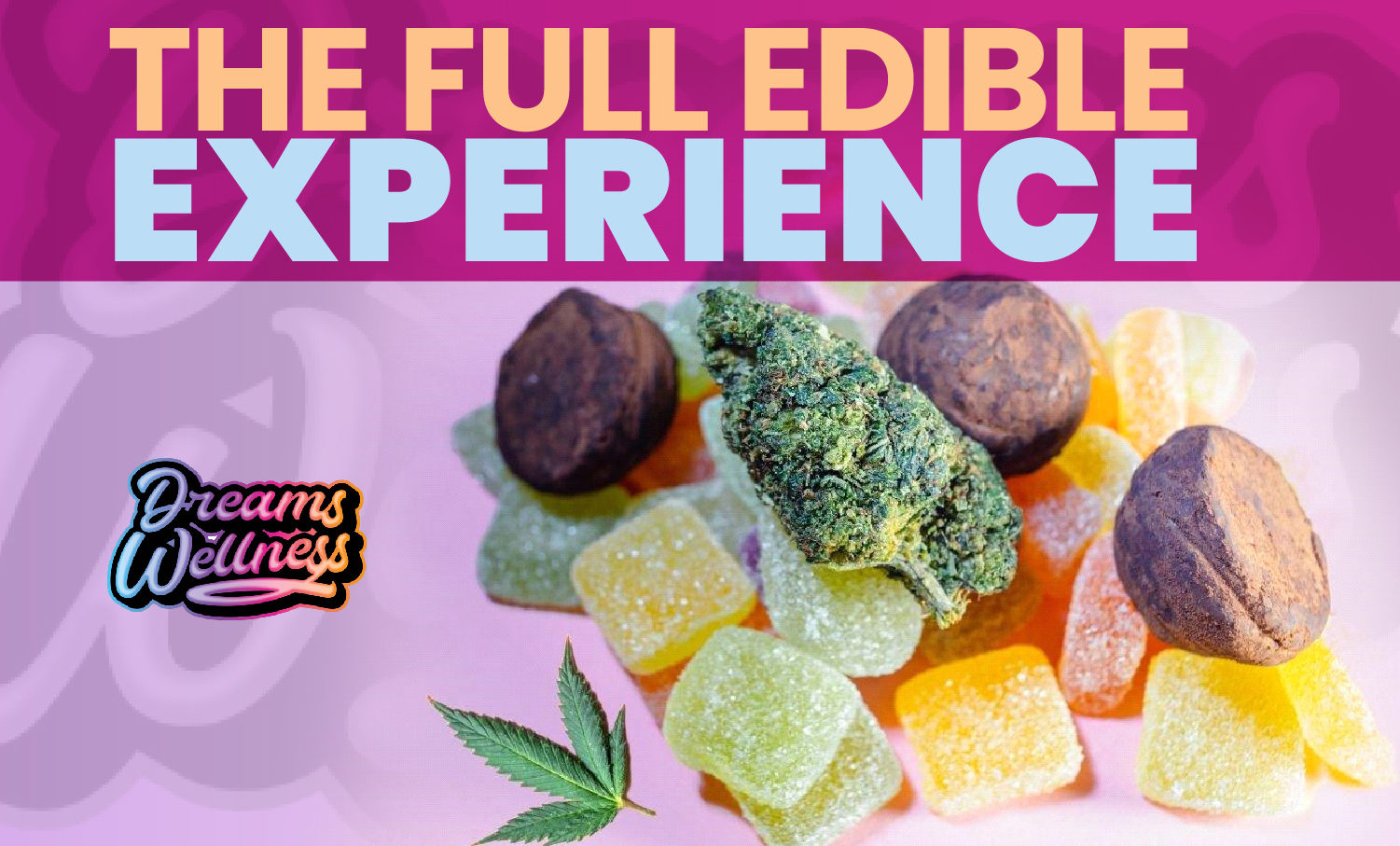
The Full Edible Experience
Whether you’re a seasoned connoisseur or a curious newcomer, the Edible Timeline Guide is designed to be a complete guide in offering insights into cannabis-infused treats. So, fasten your seatbelts and get ready to transport in the delectable world of cannabis edible products - a journey that promises to expand your appreciation for infused cannabis edible creations!
How To Dose Edibles
When indulging in edibles, it’s excellent to consider dosage to experience the best effects for you. Here are the factors to consider when dosing edibles: type of edible, metabolism, body weight, dosage, and tolerance. Two individuals taking the same edible may experience different effects based on these critical factors. Starting low and slow is your best bet when embarking on your edible journey. Learning about Microdosing and Microdosing is also essential for anyone curious about dosing weed edibles. Understanding different dosage amounts will be a great guideline for anyone interested in taking edibles**,** which we will review in depth later in this article.
Accurate dosing is crucial when considering taking cannabis-infused edibles. The potency can vary widely between products and how individuals respond differently to cannabinoids. It’s essential to start with a low dose, especially for those new to edibles, to avoid overconsumption and potential adverse effects.
How Long Does It Take For THC Edibles To Kick In?
The onset time for the effects of THC edibles can vary widely and depends on several factors, including the individual’s metabolism, edible product, and whether the person is running on an empty stomach or full. However, on average, the effects of THC edibles typically begin within 30 minutes to 2 hours after consumption. Remember to wait at least 2 hours before taking more mg of THC. Sometimes, the effects won’t hit you until the 2-hour mark. Waiting is crucial so you don’t overdose too quickly and end up with a bad and super-potent high.
How Long Does An Edible High Last?
The duration of an edible high can vary widely among individuals and depends on several factors, including dosage, individual metabolism, tolerance, and the specific cannabinoids involved (e.g., THC or CBD). On average, the effects and side effects of THC edibles can last anywhere from 4 to 12 hours. Higher doses of THC in edibles are likely to result in a more prolonged and intense high. When it comes to individual metabolism, people metabolize cannabinoids differently. Factors in play can include age and how quickly the body processes and eliminates THC. Tolerance is also considered when taking edible cannabis because individuals with a higher tolerance to THC may experience a shorter duration of effects or not as potent of a high. Conversely, those with lower tolerance or running on an empty stomach may find a low dose affects them for longer.
How Long Do Edibles Stay In Your System?
THC and the way its metabolites are often detectable in urine for several days to a few weeks after consuming edibles. It might be detectable for around 3-4 days for frequent users. However, for regular heavy users, THC metabolites can be detected for an extended period, possibly up to several weeks. Hair tests can detect THC for a much longer duration since they are present in hair follicles for months, potentially up to 90 days, depending on the length of the hair sample. THC is generally detectable in blood and saliva for a shorter duration than in urine and hair. THC levels are typically detectable in blood for up to 24-48 hours.
Remember this information if you’re planning on taking a drug test. The information provided here is general guidance, and individual circumstances can vary. Suppose you have specific concerns or are facing a drug test. In that case, consulting with a healthcare professional for personalized advice is advisable.
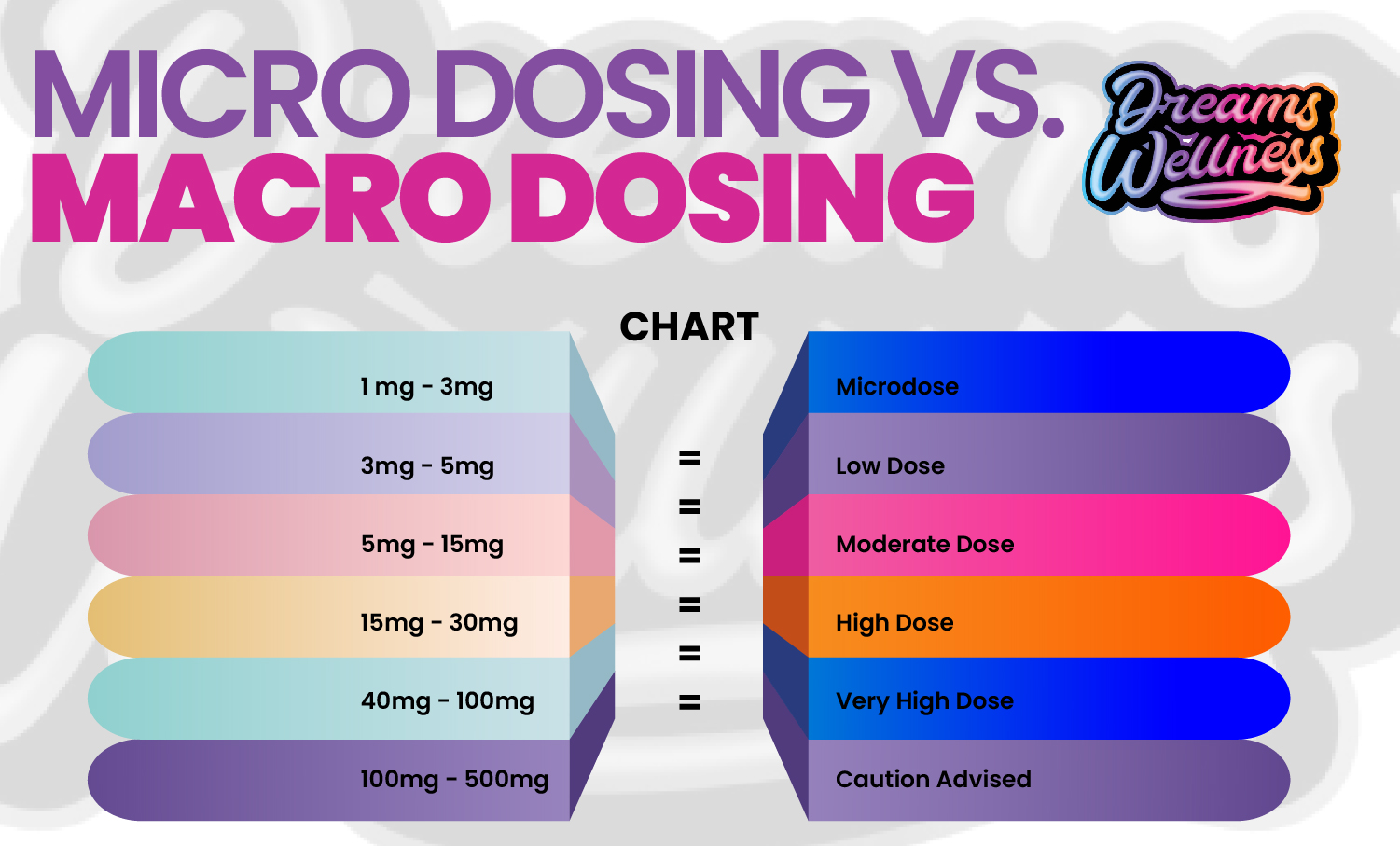
Micro Dosing Vs. Macro Dosing
Understanding Microdosing VS macro is key when embarking on your cannabis edible journey. Micro dosing involves consuming a low mg dose of cannabis-infused products to experience subtle effects without a total psychoactive high. Micro dosing often aims to enhance well-being, mood, or creativity without causing impairment. It’s thought to be a way to enjoy the potential benefits of marijuana while minimizing the risk of adverse effects. In the context of cannabis, a microdose typically contains a very low amount of THC, often below the threshold where significant psychoactive effects are felt.
Here Is Our Dosing Guide:
1 mg- 3mg- This amount of THC is perfect for those wanting to microdose. You may feelmild relief from pain, stress, and anxiety, which increases focus and productivity. Most users do not feel any psychoactive effects at such a low dose. Microdosing is great for First-time or regular consumers looking to enhance their mood throughout the day.
3mg - 5mg- Ingesting THC around this range of mg is considered a very low dosage. With this mg amount digested, you may feel more potent effects of pain relief and anxiety. It should bring on more euphoric effects that may alter your perception. For beginners, 5 mg may intoxicate your system. This amount is excellent for people looking to relieve specific medical concerns or those looking for a good night’s sleep.
5mg - 15mg- This amount of THC is for moderate-tolerance consumers and is not recommended for inexperienced users, for it may cause adverse effects. Ingesting this amount can help with nausea and anxiety. This dose is associated with altered perception and impaired coordination, so operating a vehicle may not be the best. This amount is usually taken to help with body aches and relaxation.
15mg - 30mg- This amount is considered high and will likely impair coordination and affect your perception. Ingesting this much THC is for those who have significant THC tolerance, giving you more intense euphoric feelings. This amount of THC is suitable for moderate to experienced cannabis users.
40mg - 100mg- Consuming THC in this mg range is considered to be a very high dosage. This amount should be reserved for more experienced users who have built a tolerance for cannabis and THC. Taking this amount is also great for medical patients dealing with any medical ailment requiring higher doses. The effects felt when consuming 40-100mg of THC can impair your coordination and perception as well as bring on a strong sense of euphoria.
100mg -500mg- If you’re ingesting this much THC and are able to handle it, kudos to you. This should be reserved for highly experienced users; even then, caution should be advised. With this much THC in your system, you’re most likely going to feel adverse side effects such as intense anxiety, nausea, and highly impaired perception. Medical patients with super high tolerance may use this for relieving certain medical conditions such as inflammatory disorders, cancer, or any condition requiring an extremely high dose of THC.
Macro-dosing involves consuming a higher dose of a substance, often to experience more pronounced and more intense psychoactive effects. Macro dosing aims to achieve a more significant and noticeable impact, which might include intense relaxation, euphoria, or altered perception. This approach is more likely to result in a traditional “high.” In the context of cannabis, a macro dose would typically involve ingesting a higher amount of THC, well above the threshold for subtle effects. The specific amount can vary, but it often ranges from 10 to 50 milligrams of THC or more.
Positive Effects Of Cannabis Edibles
Cannabis edibles can produce a range of positive effects, and these effects can vary among individuals based on many factors. Cannabis containing THC and CBD are known for their analgesic properties. The effects of an edible may provide relief for individuals experiencing chronic pain or various health-related conditions. Many people report a sense of relaxation, reduced stress, and a helping aid for sleep disorders. Certain cannabinoids, especially those with indica/sedative properties, may improve sleep quality. Some users report heightened creativity and enhanced sensory perception. THC can induce a feeling of euphoria and happiness, giving a mood-enhancing effect that may be helpful for individuals dealing with mood disorders or simply seeking a positive emotional experience.
Edibles may also stimulate appetite, commonly called the “munchies.” Both THC and CBD have anti-inflammatory properties, and edibles containing these cannabinoids may reduce inflammation in the body. Lastly, compared to smoking or vaping, the effects of cannabis edibles tend to last longer. They can be considered way better for your overall health. This can benefit individuals seeking sustained relief from symptoms throughout the day or night. If you want to experience any of these effects, try our high-quality edibles here at Dreams Wellness.
Negative Effects Of Cannabis Edibles
While cannabis edibles can have positive effects for many individuals, it’s essential to be aware of the potential adverse effects, especially when it comes to responsible and safe consumption. Usually, Negative effects from edibles are due to overconsumption of THC for your body’s metabolism and tolerance. One of the unique characteristics of cannabis edibles is their delayed onset of effects, which can lead to overconsumption if users do not feel immediate effects. Overconsumption is a common issue with edibles, especially among inexperienced users. Taking too much THC can lead to intense intoxication, anxiety, paranoia, and other adverse reactions.
Some individuals may be more sensitive to the psychoactive effects of THC, leading to potential feelings of paranoia. These effects can be particularly pronounced with high doses or if the individual has a low tolerance. Some people with sensitive digestive systems may also experience digestive issues such as nausea, stomach discomfort, or vomiting, which is more likely to happen with high doses. It’s essential to approach the consumption of edibles with caution and responsibility. Taking note of our dosage guidelines is the best place to start. Starting with low doses and waiting for the full effects to manifest before considering additional THC consumption. In this guide, it is highly advised not to abuse cannabis use because we want readers to be safe and have an enjoyable, edible experience!
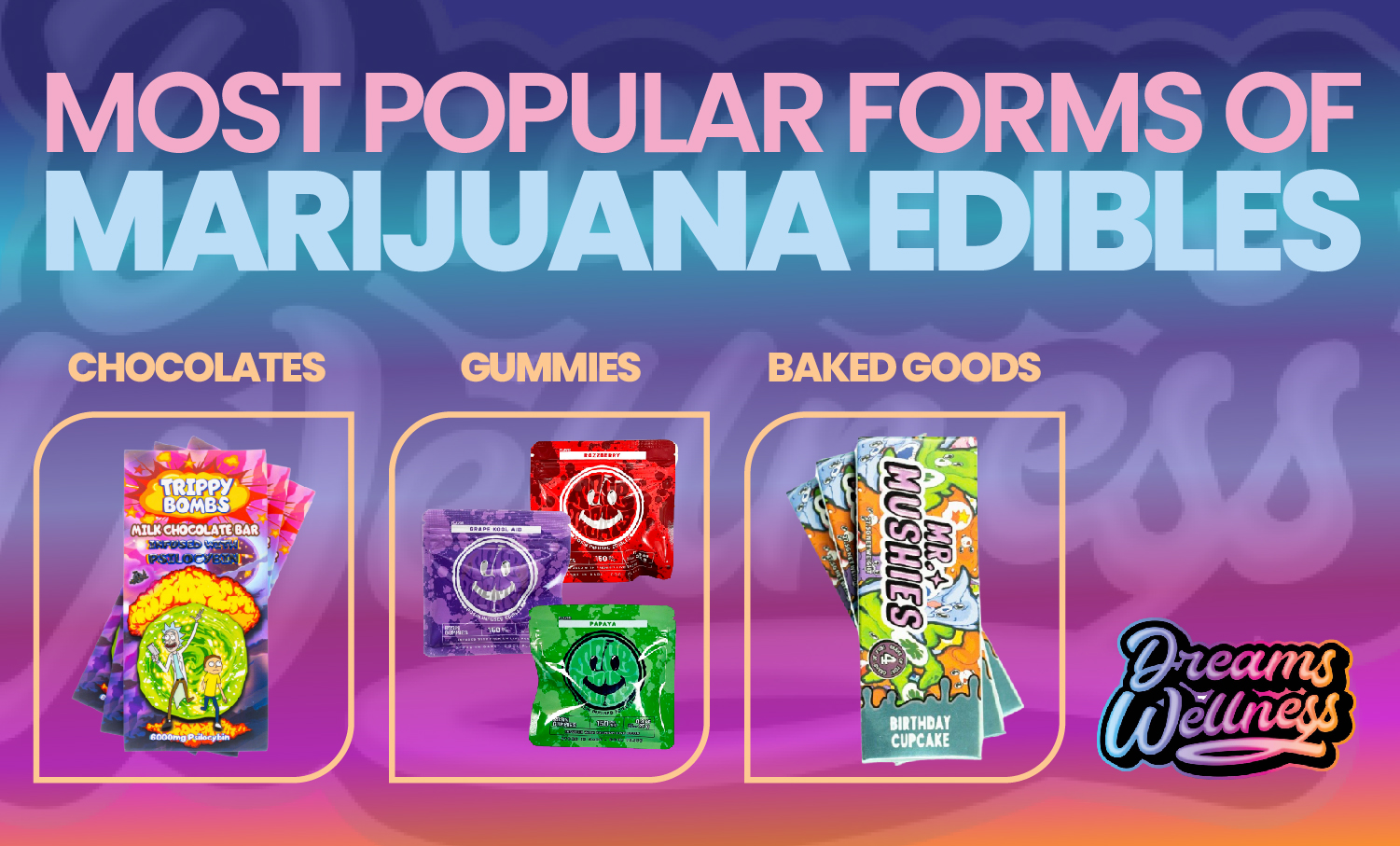
Most Popular Forms of Marijuana Edibles
Marijuana edibles come in various forms, catering to different preferences and consumption methods. The different types of edibles commonly used are brownies or baked goods, chocolates, gummies, beverages, hard candies such as lollipops, tinctures/sublingual, and pills! Depending on your mood, preference, and tolerance, the versatility of cannabis edible products makes it easy to choose from!
Chocolates
Cannabis-infused chocolates and truffles offer a tasty and discreet way to consume marijuana. These edibles usually come in decadent chocolate-infused treats and often mask the taste of cannabis. Potency varies by product, with THC concentrations clearly labeled. Dreams Wellness offers an array of chocolate cannabis-infused bars with lots of delicious flavors to choose from. Our selection includes a range of milligrams, perfect for micro and macro dosing! Dreams Wellness offers flavors such as Blackberry Dark Chocolate, Churro Milk Chocolate, Dark Chocolate, Milk Chocolate, and S’Mores Chocolate. For any chocolate lover who wants to dive into the world of chocolate edibles, Dreams Wellness has you covered! Shop in-store or online at Dreams Wellness for the best quality, mouthwatering flavors, and excellent customer satisfaction.
Gummies
THC-infused gummies are a mouthwatering option great for those who love chewy candy. Cannabis Edibles come in a variety of flavors; at Dreams Wellness, we offer the following flavors: Guava, Apple Gelato, Peach, Golden Kiwi, Jackfruit, Pineapple, Grapefruit, Coconut, Orange, Strawberry, White Nectarine, Watermelon, Honey Dew, Cherry, Pink Pineapple, Grape, Papaya, Tamarind. They are popular at Dreams Wellness for their ease of dosing, spectacular flavor profiles, high-quality THC, and creating the best edible high. Gummies typically have a consistent THC content per piece, making it easier for users to control their dosage. Try out *Dreams Wellness *for any of your cannabis-infused gummy needs!
Baked Goods
We all know and love our cannabis-infused baked Goods. Some of us had a plug growing up who would make cannabis-infused brownies that weren’t so delicious half of the time. These can come in various popular treats such as classic brownies, cookies, and cakes - these are the most iconic edibles. The potency of baked goods varies depending on who is making them, and they often have consistent amounts of THC per serving. Making your own cannabis-infused baked goods with cannabutter can be a fun experience, resulting in really yummy marijuana treats!

Edibles Vs. Smoking Marijuana
Consuming marijuana through edibles and smoking are two different methods of consumption, each with its own set of advantages, disadvantages, and effects. The benefit of consuming edibles is that it eliminates the harmful effects associated with smoking cannabis. Inhalation of smoke can have adverse respiratory effects, which is a potential risk associated with smoking. The choice between edibles and smoking often comes down to personal preference, lifestyle, and desired effects. Individuals with respiratory issues, asthma, weak lungs, or who prefer no smoke/ healthier high may prefer edibles. Effects of smoking marijuana can have a shorter length of a psychoactive high, whereas consuming edibles has a more extended THC experience, some of which reach up to 12+ hours. It comes down to preference which route you choose to take; marijuana-infused edibles have no limits!
Edible Timeline -The Bottom Line
We hope that you now understand what edibles are, cannabis infusions, types of edibles, micro-dosing vs. macro-dosing, the effects felt, and where to purchase the best cannabis gifts -Dreams Wellness. This guide is meant to prepare you if you’re entering the world of cannabis edibles, and hopefully, you can narrow down which edibles are best for you! The bottom line is to start with a low dose - specifically for beginners, be patient when waiting for the effects to kick in, and be responsible when considering additional doses. This is so you don’t experience an overdose of THC and start to feel adverse effects such as purging, paranoia, headaches, insanely impaired vision, and anxiety.
Understanding that edibles may stay in your system is crucial to know before ingestion of infused treats, so if you have a drug test coming up, be mindful of this. Make sure when picking out your desired THC-infused treats you are aware of the milligrams of THC in the product so you don’t accidentally overdose or pick an edible designed for a more experienced user. Here at Dreams Wellness, we offer various infused treats, from chocolates to gummies in various flavors that’ll blow you away! Try out our popular choices, such as our peach gummies, infused with only the best cannabis, or Kiva. This fan-favorite brand offers cannabis-infused rich and creamy chocolate bars!
We hope our complete edible timeline guide can help you embark on this exciting and fun journey! Shop Dreams Wellness for the best products, quality goods, customer service, competitive prices, and overall, the best experience when shopping for cannabis!
FAQ:
How can you tell if an edible has gone bad or expired?
Check for package damage, change of smell, mold growth, and if it has an unpleasant taste.
What is the shelf life of edibles?
Edibles generally have a longer shelf life compared to perishable foods. Make sure to check for an expiration date on the packaging.
What is the typical duration of effects from a cannabis edible?
The overall duration of effects can last anywhere from 4 to 12 hours or more. Some users may continue to feel residual effects for up to 24 hours, particularly with higher doses or if they are more sensitive to cannabinoids.
Can you provide a timeline for the peak effects of edibles?
The peak effects of cannabis edibles usually occur 2 to 4 hours after consumption. During this time, users may experience the most intense psychoactive and therapeutic effects.
